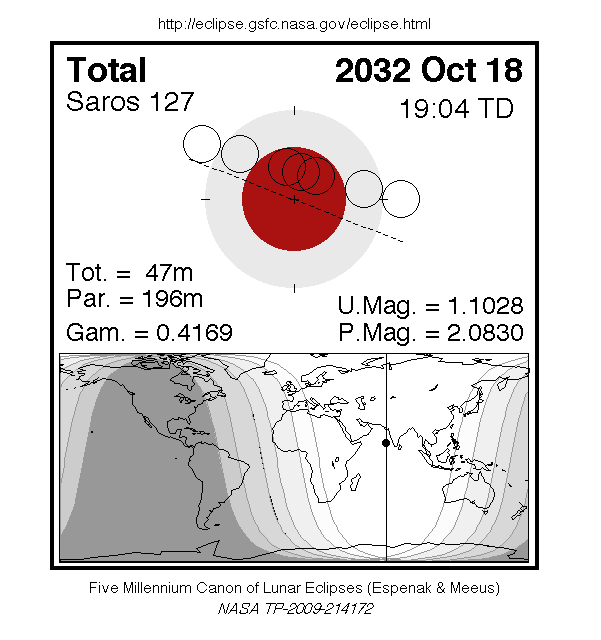A total eclipse of the Moon occurs on Monday 18 October, 2032 UT, lasting from 16:24–21:40 UT. A shallow total eclipse will see the Moon in relative darkness for 47 minutes and 6 seconds. The Moon will be 10% of its diameter into the Earth's umbral shadow, and should be significantly darkened for viewers in Europe and Asia. The partial eclipse will last for 3 hours and 16 minutes in total.
The timings of the phases of the eclipse are as
follows. You will be able to see each phase of the
eclipse if the Moon is up at the corresponding time as
seen from your location; however the penumbral phase
will be very difficult to see in practice, so you may want to start watching at the partial phase:
| Penumbral eclipse begins: |
16:24:41 UT |
| Partial eclipse begins: |
17:24:22 UT |
| Total eclipse begins: |
18:38:46 UT |
| Maximum eclipse: |
19:02:21 UT |
| Total eclipse ends: |
19:25:53 UT |
| Partial eclipse ends: |
20:40:17 UT |
| Penumbral eclipse ends: |
21:40:05 UT |
During this eclipse the Moon will be just 2 days past perigee, making it fairly large.
At maximum eclipse it will be 0.555° in apparent
diameter, which is 4.6% larger than average.
The statistics page has information on the ranges of the sizes of
the Sun and Moon, and the Moon data page displays detailed
information on the Moon's key dates.
Interactive Map
This map shows the visibility of the eclipse at various stages.
The bright area in the middle will see the whole eclipse; the coloured
bands to the right will see the start of the eclipse, and those on the
left will see the end. Note that the map is approximate, and if you are
near the edge of the area of visibility, the moon will be very close to the
horizon and may not be practically visible.
You can use the zoom controls to zoom in and out, and pan to
see areas of interest. Hover your mouse over the
tags to see what will be visible from each area on the map. The green
marker in the centre shows where the Moon will be directly
overhead at maximum eclipse.
The interactive map is currently not available.
Overview Map
This map sourced from NASA Goddard Space flight Center: GSFC Eclipse Web SiteGSFC Eclipse Web Site
The primary source of all the information on eclipses presented here at Hermit Eclipse. (NASA Goddard Space flight Center)
shows the visibility of the eclipse. (Click on it for the
full-sized version.)
Eclipse Season and Saros Series
This eclipse season contains 2 eclipses:
This is the 43rd eclipse in lunar Saros series 127.The surrounding eclipses in this Saros series are:
This Saros series, lunar Saros series 127,
is linked to solar Saros series 134. The
nearest partner eclipses in that series are:
Eclipse Parameters
| UT Date/time (max) | 19:02:21 on 18 Oct UT |
TDT Date/time (max) | 19:03:40 on 18 Oct TDT |
| Saros Series | 127 |
Number in Series | 43 |
| Penumbral Magnitiude | 2.083 |
Central Magnitiude | 1.1028 |
| Gamma | 0.4169 |
Path Width (km) | |
| Delta T | 1m19s |
Error | ± 0m14s (95%) |
| Penumbral Duration | 5h15m |
Partial Duration | 3h16m |
| Total Duration | 47m06s |
| |
| Partial Rating | |
Total Rating | |
| Sun Distance | 149015322 km (39.7%) |
Moon Distance | 364746 km (16.6%) |
| Sun Diameter | 0.535° |
Moon Diameter | 0.546° - 0.555° |
| Perigee | 21:28 on 16 Oct UT |
Apogee | 18:23 on 28 Oct UT |
| Contact p1 | 16:24:41 on 18 Oct UT |
Contact p2 | |
| Contact u1 | 17:24:22 on 18 Oct UT |
Contact u2 | 18:38:46 on 18 Oct UT |
| Max eclipse | 19:02:21 on 18 Oct UT |
| Contact u3 | 19:25:53 on 18 Oct UT |
Contact u4 | 20:40:17 on 18 Oct UT |
| Contact p3 | |
Contact p4 | 21:40:05 on 18 Oct UT |
Note that while all dates and times on this site (except
where noted) are in UT, which is within a second of civil time,
the dates and times shown in NASA's eclipse listingsGSFC Eclipse Web Site
The primary source of all the information on eclipses presented here at Hermit Eclipse. (NASA Goddard Space flight Center)
are in the TDT timescale.
The Sun and Moon distances are shown in km, and as a
percentage of their minimum - maximum distances; hence 0%
is the closest possible (Earth's perihelion, or the
Moon's closest possible perigee) and 100% is
the farthest (aphelion, the farthest apogee).
The statistics page has information on the ranges of sizes
of the Sun and Moon, and the Moon data page displays detailed
information on the Moon's key dates.
Data last updated: 2015-06-21 22:11:46 UTC.

